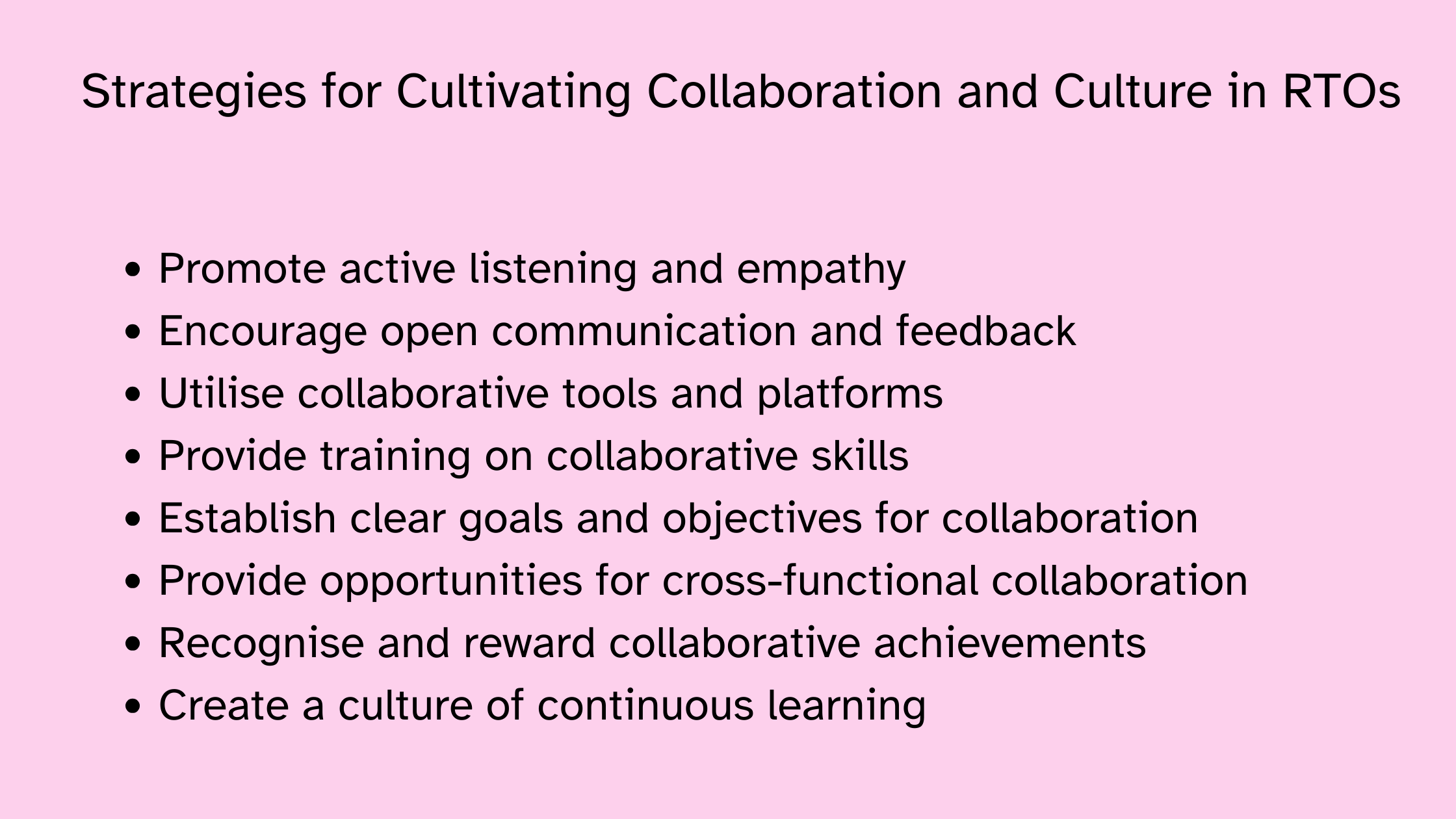In today’s fast-paced and ever-changing business landscape, the ability to foster a collaborative work culture is no longer a mere option but an essential ingredient for success. Collaboration, the art of working together towards a common goal, has emerged as a driving force behind innovation, productivity, and employee engagement. When individuals from different backgrounds and expertise come together to share ideas, perspectives, and skills, the potential for breakthroughs is limitless.
In RTOs, collaboration is not merely a desirable attribute; it is an important thing to consider. By fostering a collaborative culture in the workplace, RTOs can reap a multitude of benefits.
In this blog ‘Collaboration and Culture in workspace: How RTOs Can Gain Benefit from It’ we will explain what collaborative work is, why it is important, and how to create the same.
What does Collaboration Mean in the Context of RTOs
A culture of collaboration is a type of workspace atmosphere that focuses on bringing employees with different skills and backgrounds together and creating opportunities for them to work together towards common goals. It values the idea that when employees bring their unique capabilities together to work collectively, they can produce higher-quality work overall.
This helps the employees of an RTO to share their expertise and knowledge with each other, which helps them solve problems efficiently and makes room for creativity and innovation.
Features of Collaboration and Culture in a collaborative workplace

Here are a few features of a good and robust Collaborative Culture:
- Transparency: Discussions among teams should be based on Transparency. Empower team members by fostering open communication and ensuring that everyone has access to the information they need to do their job effectively. Create a culture of trust by encouraging team members to share their ideas and concerns without fear of reprisal.
- Sharing of knowledge: Individuals from different backgrounds and expertise should share their knowledge with other team members. Build a team of experts by encouraging team members to share their knowledge and expertise with each other. Create a culture of continuous learning by providing opportunities for team members to learn new skills and develop their expertise.
- Trust: When different teams and members come together, trust is an important factor.
- Communication: To work efficiently, team members should be able to communicate their ideas and goals to each other.
- Intentional opportunities to work together: Creating opportunities so that teams come together to work towards a common goal.
- Use of purposeful collaboration tools: Tools and resources are selected in such a way that the different teams can use and work on the same tool. Example: cloud-based.
- Engagement: Increased engagement amongst the team members. Boost team morale by creating a sense of belonging and community among team members. Increase productivity by creating a collaborative environment where team members feel motivated to contribute their best.
Benefits of Collaboration and Culture in RTOs
In the ever-evolving world of VET, collaboration is not just a good practice; it is a necessity for RTOs to thrive. Some of the benefits of Collaboration Culture are:
- Enhanced Quality and Relevance of Training: When trainers, assessors, and other staff members collaborate effectively, they can share insights, identify best practices, and ensure that the training programs are consistently aligned with industry standards and learner needs.
- Improved Learner Engagement and Outcomes: When Trainers, assessors, and staff members collaborate, they can provide learners with more personalised support, better guidance, and a more inclusive learning experience, leading to improved learner engagement and outcomes.
- Improved Curriculum Development and Training Delivery: By bringing together diverse perspectives and expertise, collaborative RTO teams can develop more relevant, engaging, and effective training programs.
- Stronger Relationships with Industry Partners and Stakeholders: Collaboration with industry partners and other stakeholders can help RTOs stay informed of industry trends, develop customised training programs, and secure employment opportunities for learners.
- Increased Employee Satisfaction and Engagement: When employees feel valued and respected, their job satisfaction and engagement soar, leading to lower turnover rates and a more positive work environment.
- Better Decision Making: Collaboration allows for a wider range of perspectives to be considered, leading to more informed decision-making about curriculum development, training delivery, and resource allocation.
Strategies for Cultivating Collaboration and Culture in RTO

There are a few things that RTOs can do to create a collaborative work culture.
- Establish clear goals and objectives for collaboration: Clearly define the goals and objectives for collaboration within the RTO, ensuring that everyone understands the purpose and desired outcomes of collaborative efforts.
- Encourage open communication and feedback: Foster a culture of open communication, where trainers, assessors, and other staff members feel comfortable sharing ideas, asking questions, and providing feedback without fear of judgment.
- Promote active listening and empathy: Encourage active listening and empathy among colleagues, ensuring that everyone feels heard and understood and that diverse perspectives are valued.
- Provide opportunities for cross-functional collaboration: Create opportunities for trainers, assessors, and other staff members from different departments or teams to work together on projects, share knowledge, and learn from each other’s expertise.
- Utilise collaborative tools and platforms: Leverage technology to facilitate collaboration. Implement project management tools, knowledge-sharing platforms, and virtual collaboration spaces to enable seamless teamwork.
- Recognise and reward collaborative achievements: Acknowledge and reward instances of collaboration, reinforcing the desired behavior and demonstrating the value placed on teamwork.
- Provide training on collaborative skills: Offer training on effective communication, teamwork, and conflict resolution skills to equip employees with the tools they need to collaborate effectively.
- Create a culture of continuous learning: Encourage trainers, assessors, and other staff members to engage in professional development opportunities, stay informed of industry trends, and share their new-found knowledge with their colleagues.

Looking to build a strong RTO with the highest quality RTO Training Materials?
At VET Resources we offer the highest quality RTO training resources. We also offer free consultation and free samples of our materials. For more information contact us here.
Conclusion
In conclusion, collaboration is not just a good practice for RTOs; it is necessary for thriving in the ever-evolving world of vocational education and training. By cultivating a collaborative work culture, RTOs can foster innovations, enhance quality, improve learner engagement and outcomes, and achieve remarkable success in fulfilling their mission of empowerment individuals and organisations and the skills and knowledge they need to succeed in the 21st century.
Frequently Asked Questions
What are some challenges of fostering a collaborative work culture in RTOs?
There are a number of challenges that RTOs may face when fostering a collaborative work culture, including:
- Overcoming individual differences: People have different personalities, working styles, and communication styles. This can make it difficult for people to work together effectively.
- Lack of trust: Trust is essential for collaboration. Without trust, people are less likely to share their ideas and work together effectively.
- Poor communication: Poor communication can lead to misunderstandings and conflict.
- Lack of time: In today’s fast-paced world, it can be difficult to find the time to collaborate effectively.
What are some tips for overcoming these challenges?
Here are some tips for overcoming the challenges of fostering a collaborative work culture in RTOs:
- Provide training on effective communication and teamwork skills.
- Create opportunities for employees to get to know each other better outside of work.
- Establish clear expectations for collaboration.
- Hold employees accountable for their collaborative efforts.
- Celebrate successes and recognise individual contributions.
By following these tips, RTOs can create a collaborative work culture that will benefit everyone involved.
Disclaimer:
The information presented on the VET Resources blog is for general guidance only. While we strive for accuracy, we cannot guarantee the completeness or timeliness of the information. VET Resources is not responsible for any errors or omissions, or for the results obtained from the use of this information. Always consult a professional for advice tailored to your circumstances.






